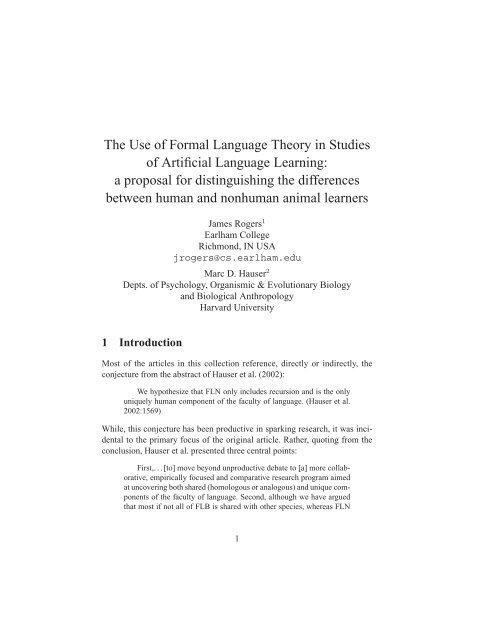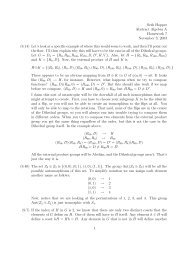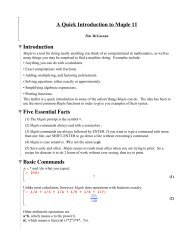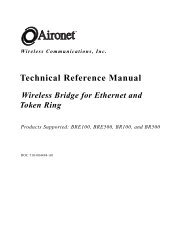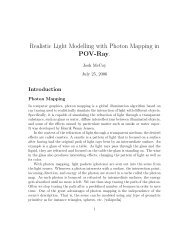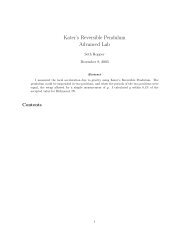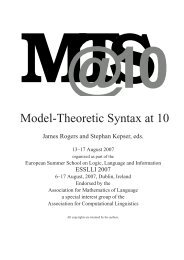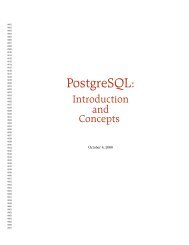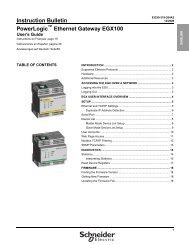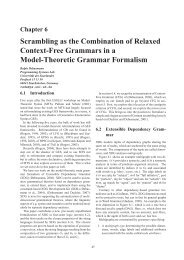The Use of Formal Language Theory in Studies of Artificial - CiteSeerX
The Use of Formal Language Theory in Studies of Artificial - CiteSeerX
The Use of Formal Language Theory in Studies of Artificial - CiteSeerX
Create successful ePaper yourself
Turn your PDF publications into a flip-book with our unique Google optimized e-Paper software.
<strong>The</strong> <strong>Use</strong> <strong>of</strong> <strong>Formal</strong> <strong>Language</strong> <strong>The</strong>ory <strong>in</strong> <strong>Studies</strong><strong>of</strong> <strong>Artificial</strong> <strong>Language</strong> Learn<strong>in</strong>g:a proposal for dist<strong>in</strong>guish<strong>in</strong>g the differencesbetween human and nonhuman animal learnersJames Rogers 1Earlham CollegeRichmond, IN USAjrogers@cs.earlham.eduMarc D. Hauser 2Depts. <strong>of</strong> Psychology, Organismic & Evolutionary Biologyand Biological AnthropologyHarvard University1 IntroductionMost <strong>of</strong> the articles <strong>in</strong> this collection reference, directly or <strong>in</strong>directly, theconjecture from the abstract <strong>of</strong> Hauser et al. (2002):We hypothesize that FLN only <strong>in</strong>cludes recursion and is the onlyuniquely human component <strong>of</strong> the faculty <strong>of</strong> language. (Hauser et al.2002:1569)While, this conjecture has been productive <strong>in</strong> spark<strong>in</strong>g research, it was <strong>in</strong>cidentalto the primary focus <strong>of</strong> the orig<strong>in</strong>al article. Rather, quot<strong>in</strong>g from theconclusion, Hauser et al. presented three central po<strong>in</strong>ts:First,. . . [to] move beyond unproductive debate to [a] more collaborative,empirically focused and comparative research program aimedat uncover<strong>in</strong>g both shared (homologous or analogous) and unique components<strong>of</strong> the faculty <strong>of</strong> language. Second, although we have arguedthat most if not all <strong>of</strong> FLB is shared with other species, whereas FLN1
may be unique to humans, this represents a tentative, testable hypothesis<strong>in</strong> need <strong>of</strong> further empirical <strong>in</strong>vestigation. F<strong>in</strong>ally, we believe that acomparative approach is most likely to lead to new <strong>in</strong>sights about bothshared and derived features, thereby generat<strong>in</strong>g new hypotheses concern<strong>in</strong>gthe evolutionary forces that led to the design <strong>of</strong> the faculty <strong>of</strong>language. (Hauser et al. 2002:1578)Our goal here is to contribute to that research program by explor<strong>in</strong>g criteriafor experimental design <strong>of</strong> comparative studies across different populations,<strong>in</strong>clud<strong>in</strong>g different species, age groups, and subjects with neurologicaldeficits, target<strong>in</strong>g capabilities relevant to the language faculty.<strong>The</strong> comparative method provides a way <strong>of</strong> analyz<strong>in</strong>g evolutionary phenomena<strong>in</strong> the absence <strong>of</strong> genetic or fossil evidence, us<strong>in</strong>g empirical dataconcern<strong>in</strong>g contrasts and parallels between traits <strong>in</strong> liv<strong>in</strong>g species to draw<strong>in</strong>ferences about their ext<strong>in</strong>ct ancestors. In particular, we are look<strong>in</strong>g to identifyshared and unique components <strong>of</strong> the faculty <strong>of</strong> language, to identifywhich <strong>of</strong> the shared traits are actually homologous rather than <strong>in</strong>dependentlyevolved under similar constra<strong>in</strong>ts, to dist<strong>in</strong>guish whether current discont<strong>in</strong>uities<strong>in</strong> traits between species are the result <strong>of</strong> gradual divergence or reflectdiscont<strong>in</strong>uities <strong>in</strong> human evolution and to dist<strong>in</strong>guish whether human traitsevolved by gradual extension <strong>of</strong> common preexist<strong>in</strong>g communication systemsor were exapted away from previous non-language adaptive functions.Empirical tests <strong>of</strong> such issues require studies <strong>of</strong> differential capabilities acrossspecies, <strong>in</strong> both communication and non-communication doma<strong>in</strong>s, <strong>in</strong>clud<strong>in</strong>gboth spontaneous and tra<strong>in</strong>ed behaviors.To set the stage for what follows, consider a study, cited <strong>in</strong> Hauser et al.(2002), reported <strong>in</strong> Fitch and Hauser (2004). This study employed familiarization/discrim<strong>in</strong>ationexperiments to test the ability <strong>of</strong> cotton-top tamar<strong>in</strong>monkeys to spontaneously generalize patterns <strong>of</strong> CV syllables spoken by afemale (A) and a male (B) voice. <strong>The</strong> experiments were designed to contrastthe ability <strong>of</strong> the subjects to recognize sequences <strong>of</strong> the form (AB) n , <strong>in</strong> whichsyllables <strong>of</strong> the two classes alternate, with the ability to recognize sequences<strong>of</strong> the form A n B n , <strong>in</strong> which there are equal numbers <strong>of</strong> syllables from eachclass, all those from one preced<strong>in</strong>g all those from the other. <strong>The</strong> form (AB) nwas chosen as an example <strong>of</strong> the class <strong>of</strong> F<strong>in</strong>ite State str<strong>in</strong>gsets, str<strong>in</strong>gsets <strong>in</strong>which there is an a priori bound on the amount <strong>of</strong> <strong>in</strong>formation that must be <strong>in</strong>ferred<strong>in</strong> dist<strong>in</strong>guish<strong>in</strong>g str<strong>in</strong>gs that fit the pattern from those that do not. <strong>The</strong>form A n B n was chosen as an exemplar <strong>of</strong> the class <strong>of</strong> Context Free str<strong>in</strong>gsets,str<strong>in</strong>gsets that can be generated by Context Free Grammars (CFGs) and for2
which, <strong>in</strong> pr<strong>in</strong>ciple, the amount <strong>of</strong> <strong>in</strong>formation required to dist<strong>in</strong>guish str<strong>in</strong>gsthat fit the pattern is proportional to the length <strong>of</strong> the str<strong>in</strong>g. Human languagesare generally believed to be at least as complicated as Context Free str<strong>in</strong>gsets.<strong>The</strong> ease with which the tamar<strong>in</strong>s mastered the F<strong>in</strong>ite State pattern, <strong>in</strong>contrast to their <strong>in</strong>ability to master the Context Free pattern, suggests that theability to generalize non-F<strong>in</strong>ite-State patterns has evolved <strong>in</strong> humans s<strong>in</strong>cethe divergence between their ancestors and the ancestors <strong>of</strong> tamar<strong>in</strong>s. Thisresult, aga<strong>in</strong>, has been fruitful <strong>in</strong> spawn<strong>in</strong>g further research, both <strong>in</strong> terms <strong>of</strong>comparative evidence and <strong>in</strong> terms <strong>of</strong> ref<strong>in</strong><strong>in</strong>g the potential underly<strong>in</strong>g mechanism(Gentner et al. 2006; Perruchet and Rey 2005; Zimmerer and Varley2007). But one <strong>of</strong> the th<strong>in</strong>gs that is clear <strong>in</strong> review<strong>in</strong>g the research thus faris that the problem <strong>of</strong> design<strong>in</strong>g such experiments and, <strong>in</strong> particular, <strong>of</strong> <strong>in</strong>terpret<strong>in</strong>gtheir results, is extremely challeng<strong>in</strong>g. We turn next to a proposal forhow one might beneficially cont<strong>in</strong>ue this l<strong>in</strong>e <strong>of</strong> research, and <strong>in</strong> particular, setup a range <strong>of</strong> patterns or str<strong>in</strong>gsets that enable more systematic explorationsand discoveries <strong>of</strong> the underly<strong>in</strong>g psychological mechanisms.2 <strong>Formal</strong> design <strong>of</strong> recognition experimentsWhile very different cognitive processes are <strong>in</strong>volved, tra<strong>in</strong><strong>in</strong>g experimentsand familiarization/discrim<strong>in</strong>ation experiments have essentially the same formalstructure. We will concentrate on the latter. In these experiments, subjectsare familiarized with the <strong>in</strong>tended str<strong>in</strong>gset by exposure to some sample <strong>of</strong> thestr<strong>in</strong>gs <strong>in</strong> the set. <strong>The</strong>y are then tested with some sample <strong>of</strong> str<strong>in</strong>gs <strong>in</strong>clud<strong>in</strong>gboth those <strong>in</strong> and those not <strong>in</strong> the <strong>in</strong>tended set. <strong>The</strong> task <strong>of</strong> the subject,then, is to <strong>in</strong>fer the pattern <strong>of</strong> a relatively large, possibly <strong>in</strong>f<strong>in</strong>ite, str<strong>in</strong>gsetfrom a small sample. As they are exposed to only positive examples, anystr<strong>in</strong>gset that <strong>in</strong>cludes this sample is consistent. Clearly the subjects cannotextract patterns that are more complicated than they are able to dist<strong>in</strong>guish.Our expectation, as well, is that the subjects will not consistently fail to extractpatterns <strong>of</strong> a given level <strong>of</strong> complexity if they are capable <strong>of</strong> recogniz<strong>in</strong>gthem. Thus, the str<strong>in</strong>gset they arrive at is an <strong>in</strong>dicator <strong>of</strong> the capacity <strong>of</strong> thecognitive mach<strong>in</strong>ery they can br<strong>in</strong>g to bear on the task.If a subject consistently, over a variety <strong>of</strong> str<strong>in</strong>gs, f<strong>in</strong>ds str<strong>in</strong>gs with<strong>in</strong> the<strong>in</strong>tended set to be “unsurpris<strong>in</strong>g” and those not <strong>in</strong> it to be “surpris<strong>in</strong>g” (wherethese terms refer to the relative novelty <strong>of</strong> the stimuli and the extent to whichthey trigger greater attention or more robust responses) then there is reason3
to conclude that they have generalized correctly. From such results, we arelicensed to conclude that the target species has cognitive faculties sufficientto recognize str<strong>in</strong>gsets <strong>of</strong> at least this level <strong>of</strong> complexity. If a subject consistently,over a variety <strong>of</strong> str<strong>in</strong>gs, f<strong>in</strong>ds some str<strong>in</strong>g <strong>in</strong> the <strong>in</strong>tended set to besurpris<strong>in</strong>g or some str<strong>in</strong>g not <strong>in</strong> the <strong>in</strong>tended set to be unsurpris<strong>in</strong>g, then onecan conclude that they have not extracted the <strong>in</strong>tended pattern. If subjects <strong>of</strong>a particular species do this consistently, over a variety <strong>of</strong> str<strong>in</strong>gsets with<strong>in</strong> agiven complexity class, then we may plausibly conclude that the species doesnot have the cognitive faculties required to recognize str<strong>in</strong>gsets <strong>of</strong> that level<strong>of</strong> complexity.<strong>The</strong> primary issue for the experimental design is determ<strong>in</strong><strong>in</strong>g which setthe subject has generalized to. <strong>The</strong>re will always be simpler sets that are consistentwith the familiarization set (the set <strong>of</strong> all str<strong>in</strong>gs over the relevant alphabet,for example) and <strong>in</strong> general these will <strong>in</strong>clude both supersets andsubsets <strong>of</strong> the <strong>in</strong>tended set. <strong>The</strong> str<strong>in</strong>gs <strong>in</strong> the set A n B n , for example, havea variety <strong>of</strong> different features which could be generalized by the subject. Forexample, all <strong>of</strong> the As precede all <strong>of</strong> the Bs, the str<strong>in</strong>gs are all <strong>of</strong> even lengthand the number <strong>of</strong> As is equal to the number <strong>of</strong> Bs. In any f<strong>in</strong>ite subset, therewill be additional features, upper and lower bounds on the number <strong>of</strong> As, forexample.[Insert Figure 1 here]Figure 1 illustrates the situation when the subject has been exposed to justthe str<strong>in</strong>g AAABBB. <strong>The</strong> set marked A m B n <strong>in</strong>cludes all str<strong>in</strong>gs <strong>in</strong> whichthe As precede the Bs, an extremely simple str<strong>in</strong>gset (<strong>in</strong> fact, as describedbelow, a strictly 2-local str<strong>in</strong>gset). <strong>The</strong> set marked A i B j 2|(i+j) is the subset<strong>of</strong> those that are <strong>of</strong> even length, 3 a F<strong>in</strong>ite State str<strong>in</strong>gset. <strong>The</strong> set markedA i B i i ≤ 3 is the f<strong>in</strong>ite subset <strong>of</strong> A n B n <strong>in</strong> which n is no greater than three.<strong>The</strong> set marked |w| A= |w| Bis the set <strong>of</strong> all str<strong>in</strong>gs <strong>in</strong> which As and Bs areequ<strong>in</strong>umerous, 4 a Context Free str<strong>in</strong>gset.In order to dist<strong>in</strong>guish subjects that have generalized to A n B n , and thereforemust be able to recognize at least some Context Free str<strong>in</strong>gsets, fromthose that can recognize only str<strong>in</strong>gsets <strong>of</strong> strictly lower complexity we needto expose them to str<strong>in</strong>gs that are <strong>in</strong> the set-theoretic symmetric differencebetween the simpler sets and A n B n . One can detect that the subject has generalizedto a simpler set that is a subset <strong>of</strong> the <strong>in</strong>tended set if there are str<strong>in</strong>gs<strong>in</strong> the <strong>in</strong>tended set but not <strong>in</strong> the simpler set that are surpris<strong>in</strong>g to them. Onecan detect that the subject has generalized to a simpler set that is a superset <strong>of</strong>4
the <strong>in</strong>tended set if there are str<strong>in</strong>gs <strong>in</strong> the simpler set but not <strong>in</strong> the <strong>in</strong>tendedset that are not surpris<strong>in</strong>g.Pair<strong>in</strong>g AAABBB with AABBBB, for example, can reveal whether thesubject has generalized to A n B n or A i B j 2|(i + j) and provides evidence<strong>of</strong> be<strong>in</strong>g able to recognize str<strong>in</strong>gsets beyond the F<strong>in</strong>ite State. Pair<strong>in</strong>g it withAABBB, on the other hand, dist<strong>in</strong>guishes subjects that have generalized tothe strictly local str<strong>in</strong>gset A m B n , but fails to dist<strong>in</strong>guish F<strong>in</strong>ite State fromnon-F<strong>in</strong>ite-State; AABBB will be novel to both those that have generalizedto A n B n and those that have generalized to A i B j 2|(i + j).Pair<strong>in</strong>g AAABBB with AAAABBBB can reveal whether the subjecthas erroneously generalized to A i B i i ≤ 3. Although one can never ruleout the possibility that the subject has generalized to a f<strong>in</strong>ite subset <strong>of</strong> the<strong>in</strong>tended set that happens to <strong>in</strong>clude both the str<strong>in</strong>gs <strong>in</strong> the familiarization setand those <strong>in</strong> the discrim<strong>in</strong>ation set that are <strong>in</strong> the <strong>in</strong>tended set, one can be reasonablysure that they have not generalized to a f<strong>in</strong>ite set by <strong>in</strong>clud<strong>in</strong>g str<strong>in</strong>gs<strong>in</strong> the discrim<strong>in</strong>ation set that are longer than any <strong>in</strong> the familiarization set andtherefore unlikely to be <strong>in</strong> any f<strong>in</strong>ite generalization. Thus, failure to perceiveAAAABBBB as novel suggests that the subject has not generalized to anyf<strong>in</strong>ite subset <strong>of</strong> A n B n .F<strong>in</strong>ally, AABBBA or ABABAB will appear novel even to subjectsthat can recognize only strictly local str<strong>in</strong>gsets, although they will not appearnovel to a subject that has overgeneralized to |w| A= |w| B. Thus thesestr<strong>in</strong>gs fail to provide any evidence at all about the boundary between ContextFree and simpler str<strong>in</strong>gsets. <strong>The</strong> punch l<strong>in</strong>e here is straightforward: it iscritical to the validity <strong>of</strong> these experiments that we have a clear idea not only<strong>of</strong> the <strong>in</strong>tended str<strong>in</strong>gset but also <strong>of</strong> the str<strong>in</strong>gsets that it could, potentially, bemistaken for.Even with careful choice <strong>of</strong> stimuli there are still a variety <strong>of</strong> pitfalls <strong>in</strong>design and <strong>in</strong>terpretation <strong>of</strong> these experiments that must be avoided. Examples<strong>of</strong> utterances <strong>of</strong> English that satisfy the patterns <strong>of</strong> Fitch and Hauser(2004) <strong>in</strong>clude (1a), <strong>of</strong> the form (AB) n , and (1b), <strong>of</strong> the form A n B n . 5(1) a. {(d<strong>in</strong>g dong) n }b. {people n left n }c. {people who were left (by people who were left) n left}d. {people who were left (by people who were left) 2n left}5
<strong>The</strong> fact that (1b) is well-formed is usually not clear at first encounter forn greater than two or three. <strong>The</strong> paraphrase <strong>in</strong> (1c) is much easier to parse,but it is, <strong>in</strong> fact, F<strong>in</strong>ite State. This po<strong>in</strong>ts out one <strong>of</strong> the difficulties <strong>of</strong> prob<strong>in</strong>gthe boundaries <strong>of</strong> recognition capabilities <strong>in</strong> this way. Humans seem to beable to process, with no conscious effort, many types <strong>of</strong> utterances which, asstr<strong>in</strong>gsets, are not F<strong>in</strong>ite State. But there are many well formed utterances <strong>of</strong>the same sort that are utterly opaque without careful conscious analysis. <strong>The</strong>fact that, <strong>in</strong> humans, the same stimulus may be processed with potentiallydist<strong>in</strong>ct faculties with differ<strong>in</strong>g degrees <strong>of</strong> success demonstrates the difficulty<strong>of</strong> isolat<strong>in</strong>g a particular faculty experimentally. This is one <strong>of</strong> the reasons fortest<strong>in</strong>g both spontaneous and learned behavior.A more fundamental issue is raised by the fact that (1d) represents a class<strong>of</strong> utterances that, while F<strong>in</strong>ite State, is unlikely to be accurately identified bymost English speakers without consciously search<strong>in</strong>g for the key to the pattern(i.e., the number <strong>of</strong> prepositional phrases is required to be even). Thus,while (1a) and (1d) are both F<strong>in</strong>ite State there seems to be a very dramaticdifference <strong>in</strong> the degree <strong>of</strong> difficulty <strong>of</strong> recogniz<strong>in</strong>g them. <strong>The</strong> F<strong>in</strong>ite Statestr<strong>in</strong>gsets do not, <strong>in</strong> fact, present a uniform level <strong>of</strong> difficulty <strong>of</strong> recognition.<strong>The</strong>re is a rich hierarchy <strong>of</strong> classes <strong>of</strong> str<strong>in</strong>gsets with<strong>in</strong> the F<strong>in</strong>ite Statewhich corresponds to a range <strong>of</strong> gradations <strong>in</strong> cognitive capabilities. Viewedas an <strong>in</strong>strument for prob<strong>in</strong>g the boundaries <strong>of</strong> these capabilities, the pair <strong>of</strong>str<strong>in</strong>gsets (AB) n and A n B n lack resolution. Thus it is not only importantto understand which sets the subject may erroneously <strong>in</strong>fer, it is also importantto understand what ranges <strong>of</strong> complexity classes may be relevant to thefaculties that are be<strong>in</strong>g explored.F<strong>in</strong>ally, an issue <strong>of</strong> <strong>in</strong>terpretation arises when the Fitch and Hauser (2004)result is taken as suggest<strong>in</strong>g that one <strong>of</strong> the capabilities dist<strong>in</strong>guish<strong>in</strong>g humansfrom tamar<strong>in</strong>s is a faculty for handl<strong>in</strong>g recursion. Fitch and Hauser donot claim that their results suggest that tamar<strong>in</strong>s lack a capacity for handl<strong>in</strong>grecursion, per se, only that they cannot handle phrase structure, i.e., ContextFree, patterns. In fact recursion is not actually necessary for recogniz<strong>in</strong>gthe pattern A n B n . Algorithmically, one can recognize this us<strong>in</strong>g a s<strong>in</strong>glecounter or by <strong>in</strong>ferr<strong>in</strong>g a s<strong>in</strong>gle b<strong>in</strong>ary relation over the <strong>in</strong>put. Context Freegrammars are not the only algorithmic mechanisms capable <strong>of</strong> generat<strong>in</strong>gor recogniz<strong>in</strong>g Context Free str<strong>in</strong>gsets. Results establish<strong>in</strong>g the def<strong>in</strong>itionalequivalence <strong>of</strong> dist<strong>in</strong>ct mechanisms are ubiquitous <strong>in</strong> <strong>Formal</strong> <strong>Language</strong> <strong>The</strong>ory(FLT), suggest<strong>in</strong>g that there is no bound on the varieties <strong>of</strong> algorithmic6
mechanisms that are equivalent <strong>in</strong> the sense <strong>of</strong> def<strong>in</strong><strong>in</strong>g the same classes <strong>of</strong>str<strong>in</strong>gsets. Consequently, one cannot make <strong>in</strong>ferences about cognitive mechanismsbased on the details <strong>of</strong> any particular generative mechanism. Ratherone is licensed only to make <strong>in</strong>ferences based on the common characteristics<strong>of</strong> the entire class <strong>of</strong> equivalent mechanisms. <strong>The</strong> question is, how are thosecommon characteristics to be determ<strong>in</strong>ed?3 Dual characterizations <strong>of</strong> complexity classesMost <strong>of</strong> FLT has developed from a foundation <strong>of</strong> abstract algorithmic processes:grammars, which generate str<strong>in</strong>gs, and automata, which recognizethem (Hopcr<strong>of</strong>t and Ullman 1979). <strong>The</strong> characteristics <strong>of</strong> these processes allowone to reason about the structure <strong>of</strong> the str<strong>in</strong>gsets they def<strong>in</strong>e, establish<strong>in</strong>gpump<strong>in</strong>g lemmas, 6 for example, or Nerode-style characterizations. 7 An understand<strong>in</strong>g<strong>of</strong> this structure is critical to the design <strong>of</strong> experiments <strong>of</strong> the sortwe are <strong>in</strong>terested <strong>in</strong>: How are the classes <strong>of</strong> str<strong>in</strong>gsets related to each other?Which str<strong>in</strong>gsets dist<strong>in</strong>guish the classes?In parallel with these algorithmic characterizations, are descriptive characterizations,characterizations <strong>of</strong> classes <strong>of</strong> str<strong>in</strong>gsets based directly on theproperties <strong>of</strong> the str<strong>in</strong>gs they conta<strong>in</strong> (Medvedev 1964; Büchi 1960; Elgot1961; Thatcher and Wright 1968; McNaughton and Papert 1971; Thomas1982; Straub<strong>in</strong>g 1994; Libk<strong>in</strong> 2004). When one specifies a str<strong>in</strong>gset withproperties such as “there are equal numbers <strong>of</strong> syllables from each class <strong>of</strong>syllables” one is specify<strong>in</strong>g the str<strong>in</strong>gset descriptively. Descriptive characterizations<strong>of</strong> classes <strong>of</strong> str<strong>in</strong>gsets focus on the nature <strong>of</strong> the <strong>in</strong>formation requiredto dist<strong>in</strong>guish str<strong>in</strong>gs that meet or do not meet such patterns—the k<strong>in</strong>ds <strong>of</strong> relationshipsbetween the components <strong>of</strong> the str<strong>in</strong>gs that must be detected if thepatterns are to be recognized. 8 <strong>The</strong> ma<strong>in</strong> strength <strong>of</strong> these characterizations,from our po<strong>in</strong>t <strong>of</strong> view, is that they do not presuppose any particular algorithmicmechanism. Any mechanism that can recognize or generate str<strong>in</strong>gsetsthat fall properly with<strong>in</strong> a descriptive class must necessarily be sensitive tothe sort <strong>of</strong> <strong>in</strong>formation about str<strong>in</strong>gs that determ<strong>in</strong>es the class. Hence theyprovide a foundation for reason<strong>in</strong>g about the common characteristics <strong>of</strong> entireclasses <strong>of</strong> formally equivalent mechanisms, be they abstract algorithmicmechanisms or concrete cognitive mechanisms realized <strong>in</strong> organisms.A second strength is their generality. Any description <strong>of</strong> str<strong>in</strong>gs that canbe expressed with<strong>in</strong> the means <strong>of</strong> a descriptive class def<strong>in</strong>es a str<strong>in</strong>gset with<strong>in</strong>7
that class. By vary<strong>in</strong>g these means systematically we can cover an extremelybroad range <strong>of</strong> seem<strong>in</strong>gly disparate ways <strong>of</strong> specify<strong>in</strong>g patterns with a relativelysmall set <strong>of</strong> descriptive classes.<strong>The</strong> fulcrum <strong>of</strong> the methodology we employ here is the deep fact thatthese two approaches to dist<strong>in</strong>guish<strong>in</strong>g classes <strong>of</strong> str<strong>in</strong>gsets correspond. Descriptiveclasses can be characterized <strong>in</strong> terms <strong>of</strong> grammars and automata andvice versa. This allows us to use the descriptive characterizations as the basisfor reason<strong>in</strong>g about cognitive mechanisms (avoid<strong>in</strong>g the fallacy <strong>of</strong> bas<strong>in</strong>gsuch reason<strong>in</strong>g on the correspond<strong>in</strong>g algorithmic mechanisms) while us<strong>in</strong>gthe algorithmic characterizations to guide the experimental design.4 <strong>The</strong> sub-regular hierarchy<strong>The</strong> range <strong>of</strong> complexity classes that falls between str<strong>in</strong>gsets such as (1a)and (1d), the sub-regular hierarchy, has been largely overlooked by l<strong>in</strong>guists<strong>in</strong> part because the Chomsky hierarchy starts with the F<strong>in</strong>ite State and <strong>in</strong>part because, as human languages are widely assumed to be at least ContextFree, there has been little motivation to explore sub-F<strong>in</strong>ite-State classes<strong>in</strong> this context. But our <strong>in</strong>terest is <strong>in</strong> recognition capabilities across manypopulations, <strong>in</strong>clud<strong>in</strong>g different species, age groups and neurological populations,target<strong>in</strong>g potential precursors to human faculties. Consequently, weare fundamentally <strong>in</strong>terested <strong>in</strong> classes <strong>of</strong> str<strong>in</strong>gsets that are simpler than humanlanguages as these may well form some <strong>of</strong> the critical evolutionary andontogenetic build<strong>in</strong>g blocks. More importantly, the classes <strong>in</strong> the sub-regularhierarchy correspond to a clear hierarchy <strong>of</strong> cognitive mechanisms and, s<strong>in</strong>cethe classes <strong>in</strong> the hierarchy are def<strong>in</strong>ed purely <strong>in</strong> terms <strong>of</strong> types <strong>of</strong> relationshipsbetween positions <strong>in</strong> str<strong>in</strong>gs, that hierarchy <strong>of</strong> cognitive mechanismswill be relevant to any faculty that provides a syntax-like function, i.e., thatprocesses stimuli solely as sequences <strong>of</strong> events, <strong>in</strong>dependent <strong>of</strong> mean<strong>in</strong>g.<strong>The</strong> rema<strong>in</strong>der <strong>of</strong> this section presents a brief overview <strong>of</strong> the formal aspects<strong>of</strong> the sub-regular hierarchy. Due to space limitations we skip most <strong>of</strong>the formal detail, present<strong>in</strong>g just the relevant characteristics <strong>of</strong> the classes<strong>of</strong> the hierarchy. We close the section with a list <strong>of</strong> criteria for the designand <strong>in</strong>terpretation <strong>of</strong> acoustic pattern recognition experiments based on theseclasses. A more through exposition can be found <strong>in</strong> Rogers and Pullum (2007).8
4.1 Strictly Local Str<strong>in</strong>gsets<strong>The</strong> simplest def<strong>in</strong>itions we will explore are those that specify str<strong>in</strong>gs solely<strong>in</strong> terms <strong>of</strong> the sequences <strong>of</strong> symbols that are permitted to occur adjacently <strong>in</strong>them, that is, <strong>in</strong> terms <strong>of</strong> the n-grams mak<strong>in</strong>g up the str<strong>in</strong>g. S<strong>in</strong>ce our n-gramsare not associated with probabilities we will refer to them with the standardFLT term<strong>in</strong>ology: k-factors.A k-factor is just a length k sequence <strong>of</strong> symbols. A Strictly k-LocalDef<strong>in</strong>ition is a set <strong>of</strong> k-factors drawn from some f<strong>in</strong>ite alphabet <strong>of</strong> symbolsaugmented with beg<strong>in</strong>n<strong>in</strong>g <strong>of</strong> str<strong>in</strong>g (⋊) and end <strong>of</strong> str<strong>in</strong>g (⋉) markers. Astr<strong>in</strong>g w satisfies a strictly k-local def<strong>in</strong>ition if and only if (iff ) the set <strong>of</strong>k-factors <strong>of</strong> the augmented str<strong>in</strong>g ⋊w⋉ is a subset <strong>of</strong> those <strong>in</strong>cluded <strong>in</strong> thedef<strong>in</strong>ition. A str<strong>in</strong>gset is <strong>in</strong> the class SL k iff it can be def<strong>in</strong>ed with a strictlyk-local def<strong>in</strong>ition, it is Strictly Local (SL) (McNaughton and Papert 1971) iffit is SL k for some k.<strong>The</strong> set <strong>of</strong> str<strong>in</strong>gs <strong>of</strong> the form (AB) n is an example <strong>of</strong> an SL 2 str<strong>in</strong>gset,be<strong>in</strong>g def<strong>in</strong>able by the (m<strong>in</strong>imal) set <strong>of</strong> 2-factors:(2) D (AB) ndef= {⋊A, AB, BA, B⋉},which asserts that the str<strong>in</strong>g must beg<strong>in</strong> with an A, end with a B, that everyA is followed by a B and that every B other than the last is followed byan A. <strong>The</strong> set <strong>of</strong> str<strong>in</strong>gs licensed by this def<strong>in</strong>ition, denoted L(D (AB) n), is{(AB) i | i > 0}.Membership <strong>in</strong> a Strictly Local str<strong>in</strong>gset depends only on the k-factors <strong>in</strong>isolation: a str<strong>in</strong>g satisfies an SL k def<strong>in</strong>ition iff each <strong>of</strong> the k-factors <strong>in</strong> thestr<strong>in</strong>g is <strong>in</strong>dependently licensed by that def<strong>in</strong>ition. From a cognitive perspective,all that is required to recognize a strictly k-local str<strong>in</strong>gset is attention toeach block <strong>of</strong> k symbols which occurs <strong>in</strong> the str<strong>in</strong>g. If the str<strong>in</strong>g is presentedsequentially <strong>in</strong> time, this amounts to remember<strong>in</strong>g just the last k consecutiveevents that have been encountered.<strong>The</strong> key to reason<strong>in</strong>g about the structure <strong>of</strong> SL str<strong>in</strong>gsets <strong>in</strong> general isa theorem which characterizes them <strong>in</strong> terms <strong>of</strong> a property known as suffixsubstitution closure: a str<strong>in</strong>gset is SL iff there is some k for which it is closedunder the substitution <strong>of</strong> suffixes that beg<strong>in</strong> with the same (k − 1)-factor.This allows us to identify non-SL str<strong>in</strong>gsets and to construct m<strong>in</strong>imalpairs <strong>of</strong> str<strong>in</strong>gsets which can be diagnostic <strong>of</strong> the ability to generalize SLpatterns. One simple non-SL str<strong>in</strong>gset is the set <strong>of</strong> str<strong>in</strong>gs <strong>of</strong> As and Bs <strong>in</strong>9
which there is at least one B, a str<strong>in</strong>gset we call Some-B:(3) Some-B def = {w ∈ {A, B} ∗ | |w| B≥ 1}.To see that this is not SL k for any k, note that, for any k, str<strong>in</strong>gs <strong>of</strong> the formA...A·A...A } {{ } ·BA...A and those <strong>of</strong> the form A...AB ·A...A } {{ } ·A...Ak−1are all <strong>in</strong> Some-B, but the result <strong>of</strong> substitut<strong>in</strong>g the suffix <strong>of</strong> a str<strong>in</strong>g <strong>of</strong> thesecond form, start<strong>in</strong>g at the marked sequence <strong>of</strong> k − 1 As, for the suffix <strong>of</strong>a str<strong>in</strong>g <strong>of</strong> the first form is A...A · } A...A {{ } ·A...A which is not <strong>in</strong> Some-B. So, Some-B does not exhibit suffix substitution closure and can not bespecified with an SL-def<strong>in</strong>ition.4.2 Locally Testable Str<strong>in</strong>gsetsIn order to dist<strong>in</strong>guish str<strong>in</strong>gsets like Some-B it is necessary to differentiatebetween str<strong>in</strong>gs on the basis <strong>of</strong> the whole set <strong>of</strong> k-factors that they conta<strong>in</strong>,not just on the basis <strong>of</strong> the <strong>in</strong>dividual k-factors <strong>in</strong> isolation. Descriptions, atthis level, are k-expressions, formulae <strong>in</strong> a propositional language <strong>in</strong> whichthe atomic formulae are k-factors which are taken to be true <strong>of</strong> a str<strong>in</strong>g w iffthey occur <strong>in</strong> the augmented str<strong>in</strong>g ⋊w⋉. More complicated k-expressionsare built up from k-factors us<strong>in</strong>g the usual logical connectives, e.g., for conjunction(∧), disjunction (∨) and negation (¬). Str<strong>in</strong>gsets are Locally Testable(LT) (McNaughton and Papert 1971) iff they are def<strong>in</strong>able by a k-expression,for some k. As an example, Some-B is def<strong>in</strong>ed by the follow<strong>in</strong>g 2-expression,which is true <strong>of</strong> str<strong>in</strong>gs that either start with B or <strong>in</strong>clude AB:k−1(4) ϕ Some-Bdef= ⋊B ∨ AB<strong>The</strong> relation between str<strong>in</strong>gs and the k-expressions which holds iff the str<strong>in</strong>gsatisfies the k-expression is denoted |=; the set <strong>of</strong> str<strong>in</strong>gs licensed by a k-expression ϕ, then, is L(ϕ) def = {w | w |= ϕ}. For the k-expression ϕ Some-B ,L(ϕ Some-B ) = Some-B. As this witnesses, k-expressions have more descriptivepower than SL k def<strong>in</strong>itions. 9Because membership <strong>in</strong> an LT k str<strong>in</strong>gset depends on the whole set <strong>of</strong>k-factors that occur <strong>in</strong> a str<strong>in</strong>g k-factors can be required to occur as wellas prohibited from occurr<strong>in</strong>g and they can be required to occur <strong>in</strong> arbitraryk−110
comb<strong>in</strong>ations—to occur together, to occur only if some other comb<strong>in</strong>ation <strong>of</strong>k-factors does not occur, etc.On the other hand, membership <strong>in</strong> an LT k str<strong>in</strong>gset depends only on theset <strong>of</strong> k-factors which occur <strong>in</strong> the str<strong>in</strong>g. Any mechanism which can dist<strong>in</strong>guishstr<strong>in</strong>gs on this basis is capable <strong>of</strong> recogniz<strong>in</strong>g (some) LT k str<strong>in</strong>gset.Conversely, any mechanism that can dist<strong>in</strong>guish members <strong>of</strong> a str<strong>in</strong>gset thatis LT k (but not SL) must be able to dist<strong>in</strong>guish str<strong>in</strong>gs on this basis. Cognitively,this corresponds to be<strong>in</strong>g sensitive to the set <strong>of</strong> all k-factors that occuranywhere <strong>in</strong> the <strong>in</strong>put. If the str<strong>in</strong>gs are presented sequentially, it amountsto be<strong>in</strong>g able to remember which k-factors have and which have not beenencountered <strong>in</strong> the stimulus.An example <strong>of</strong> a str<strong>in</strong>gset that is not LT is the set <strong>of</strong> str<strong>in</strong>gs over {A, B}<strong>in</strong> which exactly one B occurs:(5) One-B def = {w ∈ {A, B} ∗ | |w| B= 1}To see that this is not LT note that, for any k, A k BA k is <strong>in</strong> One-B whileA k BA k BA k is not. S<strong>in</strong>ce these have exactly the same set <strong>of</strong> k-factors, however,there is no k-expression that can dist<strong>in</strong>guish them.4.3 FO(+1) Def<strong>in</strong>able Str<strong>in</strong>gsets<strong>The</strong> next step <strong>in</strong> extend<strong>in</strong>g the complexity <strong>of</strong> the str<strong>in</strong>gsets we can dist<strong>in</strong>guishis to add the power to discrim<strong>in</strong>ate between str<strong>in</strong>gs on the basis <strong>of</strong> the specificpositions <strong>in</strong> which blocks <strong>of</strong> symbols occur rather than simply on the basis<strong>of</strong> blocks <strong>of</strong> symbols occurr<strong>in</strong>g somewhere <strong>in</strong> the str<strong>in</strong>g. Descriptions at thislevel are first-order logical sentences (formulae with no free variables) over arestricted str<strong>in</strong>g-oriented signature. Atomic formulae assert relationships betweenvariables (x, y, . . .) rang<strong>in</strong>g over positions <strong>in</strong> the str<strong>in</strong>g: x ⊳ y (mean<strong>in</strong>gthat y is the next position follow<strong>in</strong>g x), x ≈ y (x and y are the same position)and A(x), B(x), . . . (A occurs <strong>in</strong> position x, etc.). Larger formulae arebuilt from these us<strong>in</strong>g the logical connectives and existential (∃) and universal(∀) quantification. A str<strong>in</strong>g w satisfies an existential (sub)formula (∃x)[ϕ(x)](i.e., w |= (∃x)[ϕ(x)]) iff some assignment <strong>of</strong> a position for x makes it true.It satisfies a universal (sub)formula iff all such assignments make it true. <strong>The</strong>class <strong>of</strong> str<strong>in</strong>gsets def<strong>in</strong>able <strong>in</strong> this way is denoted FO(+1).As an example, One-B is FO(+1) def<strong>in</strong>able:(6) One-B = {w ∈ {A, B} ∗ | w |= (∃x)[B(x) ∧ (∀y)[B(y) → x ≈ y] ]},11
which asserts that there is some position x <strong>in</strong> which a B occurs and that allpositions y <strong>in</strong> which B occurs are that same position. As One-B witnesses,FO(+1) def<strong>in</strong>itions are more expressive than k-expressions. 10It turns out that a str<strong>in</strong>gset is FO(+1) def<strong>in</strong>able iff it is Locally ThresholdTestable (LTT) (Thomas 1982). Such str<strong>in</strong>gsets dist<strong>in</strong>guish str<strong>in</strong>gs onlyon the multiplicity <strong>of</strong> the k-factors which occur <strong>in</strong> them and only relativeto a threshold t above which multiplicities <strong>of</strong> the k-factors cannot be dist<strong>in</strong>guished.Thischaracterization is the key to identify<strong>in</strong>g str<strong>in</strong>gsets that are notFO(+1) def<strong>in</strong>able.An example <strong>of</strong> a non-LTT, hence non-FO(+1)-def<strong>in</strong>able, str<strong>in</strong>gset is theset <strong>of</strong> str<strong>in</strong>gs over {A, B, C} <strong>in</strong> which some B occurs before any C:(7)B-before-C def = {w ∈ {A, B, C} ∗ | at least one B precedes any C} ∉ LTT.To see this, note that, for any k, A k BA k CA k and A k CA k BA k have exactlythe same number <strong>of</strong> occurrences <strong>of</strong> every k-factor and are therefore <strong>in</strong>dist<strong>in</strong>guishable<strong>in</strong> the LTT sense for any threshold t.4.4 FO(
which is satisfied either by str<strong>in</strong>gs which consist <strong>of</strong> a substr<strong>in</strong>g <strong>in</strong> which noC occurs followed by one which starts with B or by those <strong>in</strong> which, simply,no C occurs at all.If the str<strong>in</strong>gs are presented sequentially, this corresponds to be<strong>in</strong>g able toapply a fixed set <strong>of</strong> sequences <strong>of</strong> LTT-style threshold count<strong>in</strong>g recognitionstrategies. Effectively, it corresponds to be<strong>in</strong>g able to count occurrences <strong>of</strong>events up to some threshold, coupled with the capacity to reset the counterssome fixed number <strong>of</strong> times.<strong>The</strong> most useful abstract characterization <strong>of</strong> the structure <strong>of</strong> the FO(
This def<strong>in</strong>es the set <strong>of</strong> all str<strong>in</strong>gs that are <strong>of</strong> even length: it asserts that there isa subset <strong>of</strong> positions <strong>in</strong> the str<strong>in</strong>g (X 0 ) which <strong>in</strong>cludes the first position <strong>in</strong> thestr<strong>in</strong>g, alternates between <strong>in</strong>clusion and exclusion <strong>of</strong> adjacent positions anddoes not <strong>in</strong>clude the last position. 12 This formula can be modified to ignoreeveryth<strong>in</strong>g except positions labeled B, which gives a def<strong>in</strong>ition <strong>of</strong> Even-B.So MSO is a proper superclass <strong>of</strong> FO( 0}, for example, is not MSO def<strong>in</strong>able because theNerode equivalence for the set is:(12)w ≡ A n B n v ⇔ w, v ∉ {Ai B j | i, j ≥ 0} or |w| A− |w| B= |v| A− |v| B.for which there are <strong>in</strong>f<strong>in</strong>itely many equivalence classes.Cognitively, the F<strong>in</strong>ite State str<strong>in</strong>gsets characterize an extremely broadrange <strong>of</strong> mechanisms: whenever there is a fixed f<strong>in</strong>ite bound on the amount<strong>of</strong> <strong>in</strong>formation a mechanism can reta<strong>in</strong> while process<strong>in</strong>g a str<strong>in</strong>g the mechanismwill be limited to recogniz<strong>in</strong>g at most F<strong>in</strong>ite State—equivalently, MSOdef<strong>in</strong>able—str<strong>in</strong>gsets. Note, though, that the fact that an organism can recog-14
nize non-F<strong>in</strong>ite-State str<strong>in</strong>gsets does not imply that the physical mechanismsthey employ must have access to a store <strong>of</strong> unbounded size. <strong>The</strong> mechanismsmay implement an algorithm which, <strong>in</strong> pr<strong>in</strong>ciple, requires unbounded storagewhich fails on sufficiently long or sufficiently complicated <strong>in</strong>puts. Or wouldif it ever encountered such.4.6 Beyond F<strong>in</strong>ite State<strong>The</strong> ability to recognize str<strong>in</strong>gsets that are not F<strong>in</strong>ite State implies discrim<strong>in</strong>at<strong>in</strong>gbetween str<strong>in</strong>gs on the basis <strong>of</strong> <strong>in</strong>formation about the str<strong>in</strong>g the size <strong>of</strong>which depends on the length <strong>of</strong> the str<strong>in</strong>g—be<strong>in</strong>g able to count to values thatare proportional to the length <strong>of</strong> the str<strong>in</strong>g, for example. <strong>The</strong> weakest class<strong>of</strong> the Chomsky hierarchy which properly extends the class <strong>of</strong> F<strong>in</strong>ite Statestr<strong>in</strong>gsets is the class <strong>of</strong> context free str<strong>in</strong>gsets, those that can be generatedby context free grammars. But there are many ways <strong>of</strong> utiliz<strong>in</strong>g amounts <strong>of</strong><strong>in</strong>formation that depend on the length <strong>of</strong> the str<strong>in</strong>g that do not provide theability to recognize context free str<strong>in</strong>gsets <strong>in</strong> general. <strong>The</strong> s<strong>in</strong>gle counter thatsuffices to recognize A n B n can also recognize sets <strong>of</strong> well-nested brackets(the s<strong>in</strong>gle bracket Dyck str<strong>in</strong>gsets, D 1 ), but it does not suffice to recognizeD 2 , the two bracket Dyck str<strong>in</strong>gsets, for example. <strong>The</strong>re are, <strong>in</strong> fact, multiplehierarchies which partition the context free str<strong>in</strong>gsets just as the sub-regularhierarchy partitions the F<strong>in</strong>ite State str<strong>in</strong>gsets. Experiments that are <strong>in</strong>tendedto differentiate abilities beyond the F<strong>in</strong>ite State will need to be based on formalanalyses <strong>of</strong> this territory similar to the analysis <strong>of</strong> the sub-regular hierarchywe have provided here.5 Recognition experiments[ Table 1 goes here ]Tables 1 and 2 summarize the conclusions that can be drawn about thecognitive capabilities <strong>of</strong> the subjects given the results <strong>of</strong> recognition experimentsbased on the sub-regular hierarchy.To test the recognition capabilities <strong>of</strong> a species relative to these classesone could use experiments based on patterns such as those given <strong>in</strong> the Examplecolumn <strong>of</strong> Table 1. Species with the ability to recognize patterns <strong>of</strong> thatsort, hav<strong>in</strong>g been familiarized to str<strong>in</strong>gs <strong>of</strong> the form given <strong>in</strong> the In column,should generally f<strong>in</strong>d novel str<strong>in</strong>gs <strong>of</strong> that form unsurpris<strong>in</strong>g while f<strong>in</strong>d<strong>in</strong>g15
str<strong>in</strong>gs <strong>of</strong> the form given <strong>in</strong> the Out column surpris<strong>in</strong>g. If, on the other hand,subjects consistently fail to f<strong>in</strong>d str<strong>in</strong>gs <strong>of</strong> the form given <strong>in</strong> the Out columnsurpris<strong>in</strong>g after be<strong>in</strong>g familiarized to str<strong>in</strong>gs <strong>of</strong> the form given <strong>in</strong> the In column,this would be evidence that the target species is unable to dist<strong>in</strong>guishpatterns <strong>of</strong> that level <strong>of</strong> complexity.[ Insert Table 2 here ]Table 2 summarizes the conclusions that can be drawn from such results.Recognize outcomes represent lower bounds on the species’ capacity. <strong>The</strong>y<strong>in</strong>dicate that the subject has at least the cognitive capabilities given <strong>in</strong> theCognitive significance column. Fail outcomes represent upper bounds, evidencethat the subject is limited <strong>in</strong> the way <strong>in</strong>dicated <strong>in</strong> the Cognitive significancecolumn.6 ConclusionAcoustic pattern recognition or artificial language learn<strong>in</strong>g experiments providea powerful approach to understand<strong>in</strong>g the ontogenetic and evolutionarybuild<strong>in</strong>g blocks <strong>of</strong> the human language faculty, dist<strong>in</strong>guish<strong>in</strong>g what is sharedwith other species and what is uniquely human. To design experiments <strong>of</strong>this sort with highly <strong>in</strong>terpretable results, one must be clear about a bewilder<strong>in</strong>garray <strong>of</strong> formal considerations. <strong>The</strong>se <strong>in</strong>clude the cognitive capacitiesthat the experiment is designed to probe, the abstract structure <strong>of</strong> the classes<strong>of</strong> str<strong>in</strong>gsets that those capabilities characterize, the structure <strong>of</strong> the str<strong>in</strong>gsetsthe <strong>in</strong>tended str<strong>in</strong>gset may be confused with and what such confusion signifiesabout the capabilities <strong>of</strong> the subjects.<strong>The</strong> subregular hierarchy is a range <strong>of</strong> complexity classes that correspondto a range <strong>of</strong> cognitive capabilities that are, by virtue <strong>of</strong> the descriptive characteristics<strong>of</strong> the classes, necessarily relevant to any faculty that processesaural stimuli solely as sequences <strong>of</strong> events. As such it provides a clear frameworkfor resolv<strong>in</strong>g these issues. We hope that our exposition <strong>of</strong> this hierarchywill facilitate cont<strong>in</strong>ued experimentation <strong>of</strong> this type.Notes1 This work was undertaken while the first author was <strong>in</strong> residence at the Radcliffe Institutefor Advanced Study2 <strong>The</strong> authors would like to express their gratitude to Ge<strong>of</strong>f Pullum for his extensive collaborationon this work and to Barbara Scholz and the referees for their helpful suggestions.3 <strong>The</strong> expression x|y denotes the property <strong>of</strong> y be<strong>in</strong>g an <strong>in</strong>tegral multiple <strong>of</strong> x.16
4 <strong>The</strong> expression |w| denotes the length <strong>of</strong> the str<strong>in</strong>g w—the number <strong>of</strong> symbols it conta<strong>in</strong>s.<strong>The</strong> expression |w| Adenotes the number <strong>of</strong> As it conta<strong>in</strong>s.5 <strong>The</strong>se two examples are due to Ge<strong>of</strong>frey K. Pullum.6 Pump<strong>in</strong>g lemmas establish certa<strong>in</strong> types <strong>of</strong> closure properties <strong>of</strong> str<strong>in</strong>gsets: if a str<strong>in</strong>gset<strong>in</strong>cludes str<strong>in</strong>gs with length exceed<strong>in</strong>g an arbitrary but fixed bound then it also <strong>in</strong>cludes str<strong>in</strong>gs<strong>in</strong> which certa<strong>in</strong> substr<strong>in</strong>gs are repeated arbitrarily many times. Shieber (1985) and Huybregts(1984) employed results <strong>of</strong> this sort to show that certa<strong>in</strong> dialects <strong>of</strong> Swiss-German are notrepresentable as Context Free str<strong>in</strong>gsets.7 <strong>The</strong>se characterize the structure <strong>of</strong> str<strong>in</strong>gsets <strong>in</strong> terms <strong>of</strong> the way <strong>in</strong> which certa<strong>in</strong> relationson str<strong>in</strong>gs, which depend on the str<strong>in</strong>gset, partition the set <strong>of</strong> all str<strong>in</strong>gs <strong>in</strong>to equivalenceclasses.8 We provide concrete examples <strong>of</strong> what we mean by “nature <strong>of</strong> the <strong>in</strong>formation” as wesurvey a range <strong>of</strong> descriptive classes <strong>in</strong> the next section.9 It is easy to translate an SL k description <strong>in</strong>to a k-expression def<strong>in</strong><strong>in</strong>g the same str<strong>in</strong>gset,so LT k is a strict superclass <strong>of</strong> SL k .10 Aga<strong>in</strong>, k-expressions can be easily translated <strong>in</strong>to FO(+1) formulae; so FO(+1) is a strictsuperclass <strong>of</strong> LT.11 A F<strong>in</strong>ite State automaton recognizes an FO(
Hopcr<strong>of</strong>t, J. E. and J. D. Ullman1979 Introduction to Automata <strong>The</strong>ory, <strong>Language</strong>s and Computation.Addison-Wesley, Read<strong>in</strong>g, Mass.Huybregts, R.1984 <strong>The</strong> weak <strong>in</strong>adequacy <strong>of</strong> context-free phrase structure grammars. InG. J. de Haan, M. Trommelen, and W. Zonneveld, eds., Van Periferie Naar Kern,pp. 81–99. Foris Publications, Dordrecht.Libk<strong>in</strong>, L.2004 Elements <strong>of</strong> F<strong>in</strong>ite Model <strong>The</strong>ory. Texts <strong>in</strong> <strong>The</strong>oretical Computer Science.Spr<strong>in</strong>ger, Berl<strong>in</strong>/New York.McNaughton, R. and S. Papert1971 Counter-Free Automata. MIT Press, Cambridge, MA.Medvedev, Y. T.1964 On the class <strong>of</strong> events representable <strong>in</strong> a f<strong>in</strong>ite automaton. In E. F.Moore, ed., Sequential Mach<strong>in</strong>es—Selected Papers, pp. 215–227. Addison-Wesley, Read<strong>in</strong>g, Mass. Orig<strong>in</strong>ally <strong>in</strong> Russian <strong>in</strong> Avtomaty (1956), pp. 385–401.Perruchet, P. and A. Rey2005 Does the mastery <strong>of</strong> center-embedded l<strong>in</strong>guistic structures dist<strong>in</strong>guish humansfrom nonhuman primates. Psychonomic Bullet<strong>in</strong> and Review, 12:307–373.Rogers, J. and G. K. Pullum2007 Aural pattern recognition experiments and the subregular hierarchy. InMathematics <strong>of</strong> <strong>Language</strong> 10. UCLA.Shieber, S.1985 Evidence aga<strong>in</strong>st the context-freeness <strong>of</strong> human language. L<strong>in</strong>guisticsand Philosophy, 8:333–343.Straub<strong>in</strong>g, H.1994 F<strong>in</strong>ite Automata, <strong>Formal</strong> Logic and Circuit Complexity. Birkhäuser,Boston.Thatcher, J. W. and J. B. Wright1968 Generalized f<strong>in</strong>ite automata theory with an application to a decision problem<strong>of</strong> second-order logic. Mathematical Systems <strong>The</strong>ory, 2(1):57–81.Thomas, W.1982 Classify<strong>in</strong>g regular events <strong>in</strong> symbolic logic. Journal <strong>of</strong> Computer andSystems Sciences, 25:360–376.18
Zimmerer, V. and R. Varley2007 Recursive syntax <strong>in</strong> patients with severe agrammatism. Recursion <strong>in</strong>Human <strong>Language</strong>s, Ill<strong>in</strong>ois State University, Normal, Ill<strong>in</strong>ois.19
{A,B} ∗ A n B n A i B j 2|(i + j)∅∅ABABAB|w| A= |w| BAABBBAAAABBBA i B i i ≤ 3AABBBBA m B nAABBBFigure 1: Test<strong>in</strong>g recognition <strong>of</strong> A n B n .Class Example In OutSL (AB) n (AB) i+j+1 (AB) i BB(AB) jLT Some-B A i BA j A i+j+1FO(+1) One-B A i BA j+k+1 A i BA j BA kFO(
Class Outcomes Cognitive significanceSL Recognize(AB) nSensitive to a fixed length block <strong>of</strong> the immediatelyprior eventsFail Some-B Only sensitive to the immediately prior eventsLT RecognizeSome-BSensitive to which fixed length blocks <strong>of</strong> events occur<strong>in</strong> the <strong>in</strong>put, effectively be<strong>in</strong>g able to recall sequences<strong>of</strong> events that occur at arbitrary po<strong>in</strong>tsFail One-B Insensitive to multiplicity or order <strong>of</strong> blocksFO(+1) RecognizeOne-BSensitive to the multiplicity <strong>of</strong> events that occur <strong>in</strong>the <strong>in</strong>put, at least up to some fixed thresholdFailInsensitive to order <strong>of</strong> blocksFO(


